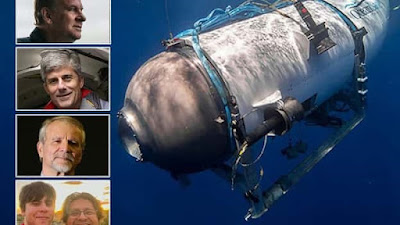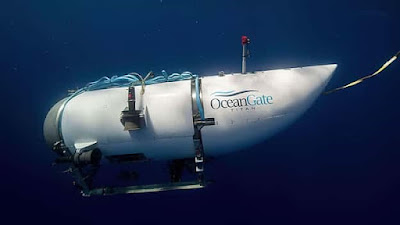…..More Details
There are palpable fears that bodies of the
five passengers aboard the Titanic sub that
was lost in a “catastrophic implosion” near the wreck may never be recovered
from Atlantic ocean, reveals the US Coast Guard.
Remains of the pressure chamber of the
OceanGate Titan was found among other debris, 1,600ft from the bow of the
Titanic on the sea floor by a remote operated vehicle (ROV) on Thursday.
In a statement on Thursday evening, OceanGate mourned the loss of the five passengers aboard the Titan and thanked international authorities for their efforts.
“These men were true explorers who shared a distinct spirit of adventure, and a deep passion for exploring and protecting the world’s oceans,” the press release read. “Our hearts are with these five souls and every member of their families during this tragic time. We grieve the loss of life and joy they brought to everyone they knew.
“This is an incredibly unforgiving environment out there on the sea floor. The debris is consistent with the catastrophic implosion of the vessel. We will continue to work and search the area down there but I don’t have an answer on prospects at this time,” said Rear Admiral John Mauger of the US Coast Guard.
And he added: “This is an incredibly complex operating environment on the sea floor over two miles beneath the surface.”
The Coast Guard says that ROVs will remain in
place but that it will begin to pull back equipment over the next 48 hours.
Recall that the Titan began its journey to the
wreck site, which sits at a depth of 12,500ft in the Atlantic Ocean, on Sunday morning,
but later lost contact with its surface ship, the Polar Prince. The Titan was
equipped with a four-day emergency oxygen supply.
More Information about
the Titan
The Titan is a five-person research
and survey submersible owned and operated by OceanGate — a private company that
provides submersibles for commercial, research and military purposes, according
to its website
It is designed to carry up to five people, usually consisting of a pilot and four crew members. Built to dive to depths of 13,123 feet (4,000 meters) and travel at 3 knots (3.5 mph, or 5.6 km/h), the craft is 22 feet (6.7 m) long and weighs 23,000 pounds (10,400 kilograms).
The Titan is a custom-built, experimental
vessel that has not been classified. Made from titanium and filament-wound
carbon fiber, the submersible is bolted shut from the outside. This means that
the crew inside cannot open it — to be let out, a team on the surface must
unseal the hatch.
The crew members can see out of the vessel and into the deep-sea gloom thanks to an array of lights, a laser and sonar scanners, as well as externally mounted cameras.
What could have happened to the missing
submersible?
It is too early to say what could have happened
to Titan, though experts have suggested a number of potential scenarios as to
how it went missing. These include power failure, electrical faults, hull
rupture, adverse weather conditions, or the submersible getting snagged on a
piece of the Titanic's wreckage.
What's the difference between a
submersible and a submarine?
Unlike submarines, submersibles cannot launch
themselves from port and return independently, according to the National Oceanic
and Atmospheric Administration, (NOAA). Instead, they rely on support
ships to carry them from port to their dive sites and back.
Titan's support ship is the Polar Prince, which
the submersible kept in communication with via regularly timed pings until
contact was lost.
Due to the risks involved in the trip,
passengers had to sign a death waiver before they embarked on the journey,
according to Mike Reiss, an American television writer and producer who has
been on a dive to the Titanic.
"To get on the boat that takes you to the
Titanic, you sign a massive waiver that you could die on the trip," Reiss
told BBC Breakfast. "On the list, they mention death three times on page
one and it's never far from your mind. As I was getting on the submarine, this
could be the end."
The missing crew consist of Hamish Harding, a
British billionaire and adventurer; Shahzada Dawood, a Pakistani-British
businessman and his son, Suleman; Stockton Rush, chief executive and founder of
OceanGate Expeditions; and Paul-Henri Nargeolet, a French submersible
pilot.


